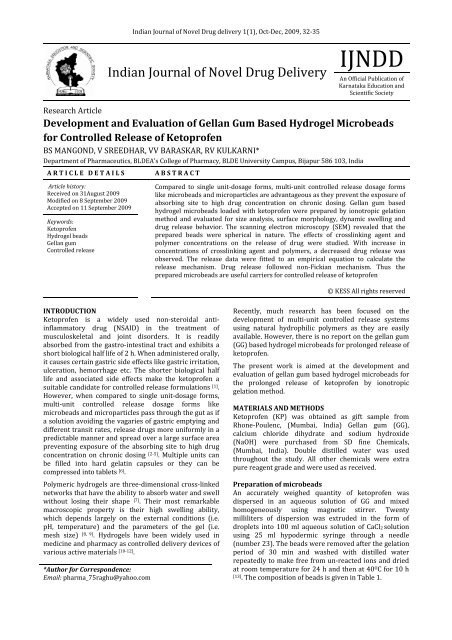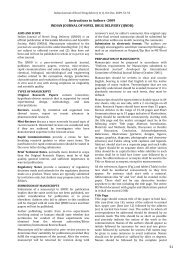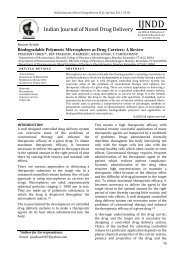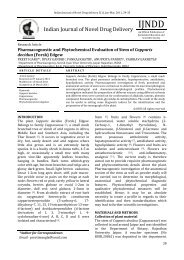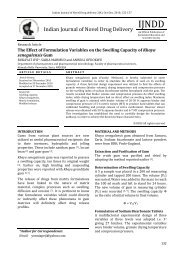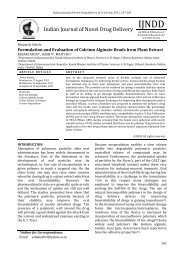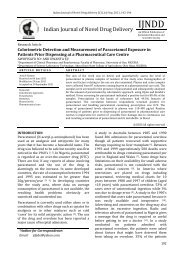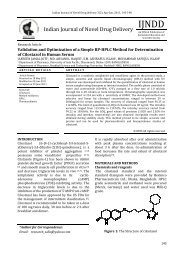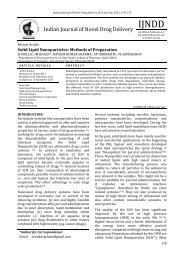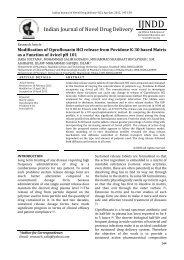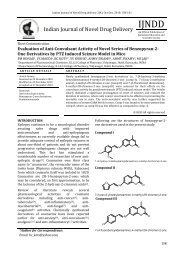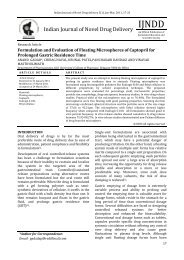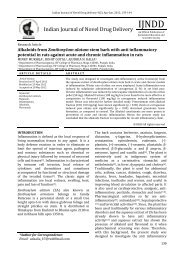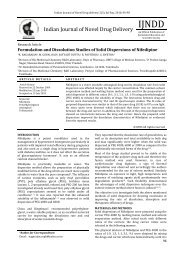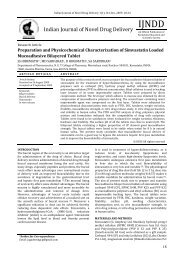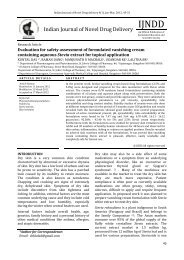Development and Evaluation of Gellan Gum Based Hydrogel ...
Development and Evaluation of Gellan Gum Based Hydrogel ...
Development and Evaluation of Gellan Gum Based Hydrogel ...
Create successful ePaper yourself
Turn your PDF publications into a flip-book with our unique Google optimized e-Paper software.
Indian Journal <strong>of</strong> Novel Drug delivery 1(1), Oct-Dec, 2009, 32-35<br />
Indian Journal <strong>of</strong> Novel Drug Delivery<br />
IJNDD<br />
An Official Publication <strong>of</strong><br />
Karnataka Education <strong>and</strong><br />
Scientific Society<br />
Research Article<br />
<strong>Development</strong> <strong>and</strong> <strong>Evaluation</strong> <strong>of</strong> <strong>Gellan</strong> <strong>Gum</strong> <strong>Based</strong> <strong>Hydrogel</strong> Microbeads<br />
for Controlled Release <strong>of</strong> Ketopr<strong>of</strong>en<br />
BS MANGOND, V SREEDHAR, VV BARASKAR, RV KULKARNI*<br />
Department <strong>of</strong> Pharmaceutics, BLDEA’s College <strong>of</strong> Pharmacy, BLDE University Campus, Bijapur 586 103, India<br />
A R T I C L E D E T A I L S<br />
A B S T R A C T<br />
Article history:<br />
Received on 31August 2009<br />
Modified on 8 September 2009<br />
Accepted on 11 September 2009<br />
Keywords:<br />
Ketopr<strong>of</strong>en<br />
<strong>Hydrogel</strong> beads<br />
<strong>Gellan</strong> gum<br />
Controlled release<br />
Compared to single unit-dosage forms, multi-unit controlled release dosage forms<br />
like microbeads <strong>and</strong> microparticles are advantageous as they prevent the exposure <strong>of</strong><br />
absorbing site to high drug concentration on chronic dosing. <strong>Gellan</strong> gum based<br />
hydrogel microbeads loaded with ketopr<strong>of</strong>en were prepared by ionotropic gelation<br />
method <strong>and</strong> evaluated for size analysis, surface morphology, dynamic swelling <strong>and</strong><br />
drug release behavior. The scanning electron microscopy (SEM) revealed that the<br />
prepared beads were spherical in nature. The effects <strong>of</strong> crosslinking agent <strong>and</strong><br />
polymer concentrations on the release <strong>of</strong> drug were studied. With increase in<br />
concentrations <strong>of</strong> crosslinking agent <strong>and</strong> polymers, a decreased drug release was<br />
observed. The release data were fitted to an empirical equation to calculate the<br />
release mechanism. Drug release followed non-Fickian mechanism. Thus the<br />
prepared microbeads are useful carriers for controlled release <strong>of</strong> ketopr<strong>of</strong>en<br />
© KESS All rights reserved<br />
INTRODUCTION<br />
Ketopr<strong>of</strong>en is a widely used non-steroidal antiinflammatory<br />
drug (NSAID) in the treatment <strong>of</strong><br />
musculoskeletal <strong>and</strong> joint disorders. It is readily<br />
absorbed from the gastro-intestinal tract <strong>and</strong> exhibits a<br />
short biological half life <strong>of</strong> 2 h. When administered orally,<br />
it causes certain gastric side effects like gastric irritation,<br />
ulceration, hemorrhage etc. The shorter biological half<br />
life <strong>and</strong> associated side effects make the ketopr<strong>of</strong>en a<br />
suitable c<strong>and</strong>idate for controlled release formulations [1] .<br />
However, when compared to single unit-dosage forms,<br />
multi-unit controlled release dosage forms like<br />
microbeads <strong>and</strong> microparticles pass through the gut as if<br />
a solution avoiding the vagaries <strong>of</strong> gastric emptying <strong>and</strong><br />
different transit rates, release drugs more uniformly in a<br />
predictable manner <strong>and</strong> spread over a large surface area<br />
preventing exposure <strong>of</strong> the absorbing site to high drug<br />
concentration on chronic dosing [2-5] . Multiple units can<br />
be filled into hard gelatin capsules or they can be<br />
compressed into tablets [6] .<br />
Polymeric hydrogels are three-dimensional cross-linked<br />
networks that have the ability to absorb water <strong>and</strong> swell<br />
without losing their shape [7] . Their most remarkable<br />
macroscopic property is their high swelling ability,<br />
which depends largely on the external conditions (i.e.<br />
pH, temperature) <strong>and</strong> the parameters <strong>of</strong> the gel (i.e.<br />
mesh size) [8, 9] . <strong>Hydrogel</strong>s have been widely used in<br />
medicine <strong>and</strong> pharmacy as controlled delivery devices <strong>of</strong><br />
various active materials [10-12] .<br />
*Author for Correspondence:<br />
Email: pharma_75raghu@yahoo.com<br />
Recently, much research has been focused on the<br />
development <strong>of</strong> multi-unit controlled release systems<br />
using natural hydrophilic polymers as they are easily<br />
available. However, there is no report on the gellan gum<br />
(GG) based hydrogel microbeads for prolonged release <strong>of</strong><br />
ketopr<strong>of</strong>en.<br />
The present work is aimed at the development <strong>and</strong><br />
evaluation <strong>of</strong> gellan gum based hydrogel microbeads for<br />
the prolonged release <strong>of</strong> ketopr<strong>of</strong>en by ionotropic<br />
gelation method.<br />
MATERIALS AND METHODS<br />
Ketopr<strong>of</strong>en (KP) was obtained as gift sample from<br />
Rhone-Poulenc, (Mumbai, India) <strong>Gellan</strong> gum (GG),<br />
calcium chloride dihydrate <strong>and</strong> sodium hydroxide<br />
(NaOH) were purchased from SD fine Chemicals,<br />
(Mumbai, India). Double distilled water was used<br />
throughout the study. All other chemicals were extra<br />
pure reagent grade <strong>and</strong> were used as received.<br />
Preparation <strong>of</strong> microbeads<br />
An accurately weighed quantity <strong>of</strong> ketopr<strong>of</strong>en was<br />
dispersed in an aqueous solution <strong>of</strong> GG <strong>and</strong> mixed<br />
homogeneously using magnetic stirrer. Twenty<br />
milliliters <strong>of</strong> dispersion was extruded in the form <strong>of</strong><br />
droplets into 100 ml aqueous solution <strong>of</strong> CaCl2 solution<br />
using 25 ml hypodermic syringe through a needle<br />
(number 23). The beads were removed after the gelation<br />
period <strong>of</strong> 30 min <strong>and</strong> washed with distilled water<br />
repeatedly to make free from un-reacted ions <strong>and</strong> dried<br />
at room temperature for 24 h <strong>and</strong> then at 40 O C for 10 h<br />
[13]<br />
. The composition <strong>of</strong> beads is given in Table 1.
RV Kulkarni et al / Indian Journal <strong>of</strong> Novel Drug Delivery 1(1), Oct-Dec, 2009, 32-35<br />
Table 1: Composition <strong>of</strong> microbeads<br />
Code<br />
GG<br />
(% w/v)<br />
Ketopr<strong>of</strong>en<br />
(% w/w <strong>of</strong> dry<br />
polymer)<br />
CaCl2<br />
(% w/v)<br />
G1 1.0 20 3<br />
G2 1.5 20 3<br />
G3 2.0 20 3<br />
G4 2.0 20 6<br />
G5 2.0 20 9<br />
G6 2.0 40 9<br />
Scanning electron microscopic studies (SEM)<br />
The microbeads were mounted onto stubs using double<br />
sided adhesive tape <strong>and</strong> sputter coated with platinum to<br />
make them conducting using sputter coater (Edward S<br />
150, UK). The coated beads were observed under<br />
scanning electron microscope (JEOL, JSM-6360, Japan) at<br />
X70 <strong>and</strong> X200 magnifications at room temperature.<br />
Measurement <strong>of</strong> bead size<br />
The microbead size was measured using a digimatic<br />
micrometer (MDC-25S Mitutoyo, Japan) having an<br />
accuracy <strong>of</strong> 0.001 mm. The average diameter <strong>of</strong> the 100<br />
beads per batch was measured [13] .<br />
Estimation <strong>of</strong> drug entrapment efficiency (DEE)<br />
Known amount <strong>of</strong> microbeads were incubated with 100<br />
ml <strong>of</strong> phosphate buffer pH 7.4 for complete swelling.<br />
Then the beads were crushed in a glass mortar with<br />
pestle, the solution was heated gently for 3 h to extract<br />
the drug completely <strong>and</strong> centrifuged to remove the<br />
polymeric debris. The clear supernant solution was<br />
analyzed for the drug content using UV-visible<br />
spectrophotometer (Model Pharmaspec UV-1700,<br />
Shimadzu, Japan) at 260 nm. The entrapment efficiency<br />
was calculated using the following equation [14] :<br />
DEE= Experimental drug content × 100<br />
Theoretical drug content …… (1)<br />
Dynamic swelling study<br />
The dynamic swelling behavior <strong>of</strong> the microbeads was<br />
studied by mass measurement. The beads were<br />
incubated with 25 ml phosphate buffer pH 7.4 in a<br />
petridish at 37 o C. The beads were taken out at different<br />
time intervals using stainless steel grid <strong>and</strong> blotted<br />
carefully without pressing hard to remove the excess<br />
surface liquid. The swollen beads were weighed using<br />
the electronic microbalance. The studies were performed<br />
in triplicate <strong>and</strong> average values were taken in data<br />
analysis [15] .<br />
In vitro drug release<br />
In-vitro drug release study was carried out in triplicate<br />
using a USP-23 rotating paddle dissolution tester<br />
(Electrolab TDT-06P, Mumbai, India). The dissolution<br />
rates were measured at 37.0 ± 0.5 o C <strong>and</strong> 50 rpm paddle<br />
speed. Drug release from the microbeads was studied in<br />
900 ml phosphate buffer medium (pH 7.4). At<br />
predetermined time intervals, 5 ml aliquots were<br />
withdrawn <strong>and</strong> replaced with the same volume <strong>of</strong> fresh<br />
solution. The samples were analyzed using UV-visible<br />
spectrophotometer at a λmax <strong>of</strong> 260 nm with suitable<br />
dilutions [13] .<br />
RESULTS AND DISCUSSION<br />
The obtained microbeads were spherical in shape having<br />
rough <strong>and</strong> dense surface with microscopic cracks on the<br />
surface as evidenced by SEM (Fig.1) <strong>and</strong> they fell in the<br />
size range <strong>of</strong> 812 to 1452 µm (Table 2). As the<br />
concentration <strong>of</strong> CaCl2 was increased, smaller beads<br />
were produced <strong>and</strong> on the other h<strong>and</strong>, by increasing the<br />
concentrations <strong>of</strong> GG <strong>and</strong> drug in the microbeads, an<br />
increase in size <strong>of</strong> the beads was observed. Table 2<br />
shows that drug entrapment efficiency (DEE) <strong>of</strong> the<br />
beads prepared with lower concentration <strong>of</strong> CaCl2 was<br />
lowest as compared to those prepared with higher<br />
concentration <strong>of</strong> CaCl2.<br />
The Fig. 2 depicts dynamic swelling behavior <strong>of</strong><br />
microbeads expressed as wt/w0 (where w0 is the initial<br />
weight <strong>of</strong> the beads <strong>and</strong> wt is the weight <strong>of</strong> beads at<br />
time‘t’) as a function <strong>of</strong> time in phosphate buffer pH 7.4.<br />
The swelling depends upon the concentration <strong>of</strong> GG <strong>and</strong><br />
extent <strong>of</strong> crosslinking in the beads. It was observed that<br />
swelling <strong>of</strong> the beads increased with an increasing<br />
amount <strong>of</strong> GG in the beads <strong>and</strong> swelling decreased with<br />
an increasing amount <strong>of</strong> CaCl2. At low crosslink density,<br />
the hydrogel network is loose with a greater<br />
hydrodynamic free volume <strong>and</strong> can absorb more <strong>of</strong> the<br />
solvent resulting in higher swelling.<br />
The release pr<strong>of</strong>ile <strong>of</strong> ketopr<strong>of</strong>en from microbeads is<br />
shown in Fig.3. The beads which were prepared with<br />
higher concentration <strong>of</strong> CaCl2 released the drug more<br />
slowly because increase in concentration <strong>of</strong> the gel<br />
forming ions provided increased rigidity <strong>of</strong> the network<br />
due to increased cross-link density. On the other h<strong>and</strong>,<br />
increase in concentration <strong>of</strong> GG the in formulations<br />
resulted in decreased drug release, which may be due to<br />
increased diffusional path length for drug penetration.<br />
Table 2: Average bead size, drug entrapment efficiency (DEE), diffusion coefficients (D) <strong>and</strong> release parameters (n)<br />
<strong>of</strong> the microbeads<br />
Beads Average size (µm) DEE (%) D (cm 2 /s) n r*<br />
G1 812 ± 2.15 52.71 ± 0.46 5.12 X 10 -4 0.56 0.981<br />
G2 1276 ± 2.87 54.85 ± 0.85 4.98 X 10 -4 0.59 0.987<br />
G3 1452 ± 4.46 56.45 ± 0.62 4.01 X 10 -4 0.62 0.994<br />
G4 1342 ± 6.70 62.89 ± 0.75 3.15 X 10 -4 0.66 0.989<br />
G5 1198 ± 5.52 70.46 ± 0.35 2.42 X 10 -4 0.73 0.986<br />
G6 1264 ± 1.78 75.56 ± 0.95 2.95 X 10 -4 0.64 0.991<br />
r* values indicate correlation coefficients<br />
33
RV Kulkarni et al / Indian Journal <strong>of</strong> Novel Drug Delivery 1(1), Oct-Dec, 2009, 32-35<br />
(<br />
(A)<br />
(B)<br />
(<br />
An increase in initial drug loading also increased the<br />
drug release. To underst<strong>and</strong> the drug release mechanism<br />
in the hydrogel network, release data was fitted to an<br />
empirical equation [16] :<br />
Mt<br />
M∞<br />
=<br />
n<br />
Kt<br />
…….. (2)<br />
In which Mt is the amount <strong>of</strong> drug released at time t, <strong>and</strong><br />
M ∞ is the total amount <strong>of</strong> drug loaded, n values are the<br />
indication <strong>of</strong> the type <strong>of</strong> release mechanism. The<br />
calculated n values along with the correlation<br />
coefficients have been shown in Table 2. The values <strong>of</strong> n<br />
depend upon the cross-link density <strong>and</strong> GG<br />
concentration; the n values increase with increase in<br />
cross-link density <strong>and</strong> GG concentration. Calculated n<br />
values suggested that the mechanism <strong>of</strong> drug release<br />
followed non-Fickian transport.<br />
Figure1. SEM photographs <strong>of</strong> single microbead (A) <strong>and</strong> its<br />
surface morphology (B).<br />
Wt/Wo<br />
8<br />
7<br />
6<br />
5<br />
4<br />
3<br />
2<br />
1<br />
0<br />
G1<br />
G2<br />
G3<br />
G4<br />
G5<br />
G6<br />
0 1 2 3 4 5 6 7<br />
Time (Hours)<br />
Figure 2: Effect <strong>of</strong> polymer concentration <strong>and</strong><br />
crosslinking agent on swelling behavior <strong>of</strong> microbeads<br />
% Drug released<br />
100<br />
90<br />
80<br />
70<br />
60<br />
50<br />
40<br />
30<br />
20<br />
10<br />
0<br />
G1<br />
G2<br />
G3<br />
G4<br />
G5<br />
G6<br />
0 1 2 3 4 5 6 7 8 9<br />
Time (Hours)<br />
Figure 3: In-vitro release pr<strong>of</strong>iles <strong>of</strong> ketopr<strong>of</strong>en from<br />
microbeads<br />
CONCLUSION<br />
The gellan gum based hydrogels microbeads were<br />
prepared by ionotropic gelation method for the<br />
controlled release <strong>of</strong> ketopr<strong>of</strong>en. The swelling <strong>of</strong> beads<br />
<strong>and</strong> drug release depends upon the polymer<br />
concentration <strong>and</strong> extent <strong>of</strong> crosslinking in the hydrogel<br />
matrix. Drug release followed non-Fickian mechanism.<br />
This work demonstrates the feasibility <strong>of</strong> preparing<br />
multiparticulate drug delivery system for controlled<br />
release <strong>of</strong> ketopr<strong>of</strong>en.<br />
Acknowledgements: Authors are thankful to Dr. N. V.<br />
Kalyane <strong>and</strong> Management <strong>of</strong> BLDE Association for<br />
providing facilities to carryout this work.<br />
REFERENCES<br />
[1] Palmieri GF, Bonacucina G, Di Martino P, Martelli S. Gastroresistant<br />
microspheres containing ketopr<strong>of</strong>en. J<br />
Microencapsul. 2002 Jan-Feb;19(1):111-9<br />
[2] Setty CM, Sahoo SS, Sa B. Alginate-coated alginatepolyethyleneimine<br />
beads for prolonged release <strong>of</strong> furosemide<br />
in simulated intestinal fluid. Drug Dev Ind Pharm. 2005<br />
May;31(4-5):435-46.<br />
[3] Tamilvanan S, Sa B. Studies on in vitro release behaviour <strong>of</strong><br />
indomethacin-loaded polystyrene microparticles. Int J Pharm.<br />
2000 May 25;201(2):187-97.<br />
[4] Halder A, Sa B. Preparation <strong>and</strong> in vitro evaluation <strong>of</strong><br />
polystyrene-coated diltiazem-resin complex by oil-in-water<br />
emulsion solvent evaporation method. AAPS PharmSciTech.<br />
2006 May 26;7(2):E46.<br />
[5] Halder A, Mukherjee S, Sa B. <strong>Development</strong> <strong>and</strong> evaluation <strong>of</strong><br />
polyethyleneimine-treated calcium alginate beads for<br />
sustained release <strong>of</strong> diltiazem. J Microencapsul. 2005<br />
Feb;22(1):67-80.<br />
[6] Galeone M, Nizzola L, Cacioli D, Mosie G. In vitro<br />
demonstration <strong>of</strong> delivery mechanism from sustained release<br />
pellets. Curr Ther Res. 1981; 29: 217-234.<br />
[7] Kulkarni RV, Sa B. Electrically responsive smart hydrogels in<br />
drug delivery: A review. J Appl Biomater Biomech. 2007; 5:<br />
125-139.<br />
[8] Siegel RA. Hydrophobic weak polyelectrolyte gels: Studies <strong>of</strong><br />
swelling equilibria <strong>and</strong> kinetics. Adv Polym Sci. 1993; 109:<br />
233-239.<br />
[9] Yao KD, Peng T, He YY. Swelling kinetics <strong>and</strong> release<br />
characteristics <strong>of</strong> crosslinked chitosan:polyether polymer<br />
34
RV Kulkarni et al / Indian Journal <strong>of</strong> Novel Drug Delivery 1(1), Oct-Dec, 2009, 32-35<br />
network (semi-IPN) hydrogels. J Polym Sci. Part A. 1994; 32:<br />
1213-1223.<br />
[10] Kulkarni RV, Sa B. Novel pH-sensitive interpenetrating<br />
network hydrogel beads <strong>of</strong> carboxymethylcellulose-<br />
(polyacrylamide-grafted-alginate) for controlled release <strong>of</strong><br />
ketopr<strong>of</strong>en: preparation <strong>and</strong> characterization. Curr Drug Deliv.<br />
2008 Oct;5(4):256-64.<br />
[11] Kulkarni RV, Sa B. Enteric delivery <strong>of</strong> ketopr<strong>of</strong>en through<br />
functionally modified poly(acrylamide-grafted-xanthan)-<br />
based pH-sensitive hydrogel beads: preparation, in vitro <strong>and</strong><br />
in vivo evaluation. J Drug Target. 2008 Feb;16(2):167-77.<br />
[12] Kulkarni RV, Sa B. <strong>Evaluation</strong> <strong>of</strong> pH-sensitivity <strong>and</strong> drug<br />
release characteristics <strong>of</strong> (polyacrylamide-grafted-xanthan)-<br />
carboxymethyl cellulose-based pH-sensitive interpenetrating<br />
network hydrogel beads. Drug Dev Ind Pharm. 2008<br />
Dec;34(12):1406-14.<br />
[13] Kulkarni RV, Sa B. Polyacrylamide-grafted-alginate based pHsensitive<br />
hydrogel beads for delivery <strong>of</strong> ketopr<strong>of</strong>en to the<br />
intestine: In vitro <strong>and</strong> in vivo evaluation. J Biomater Sci. 2009;<br />
20: 235-253.<br />
[14] Boppana R, Kulkarni RV, Mutalik SS, Setty CM, Sa B.<br />
Interpenetrating network hydrogel beads <strong>of</strong><br />
carboxymethylcellulose <strong>and</strong> egg albumin for controlled<br />
release <strong>of</strong> lipid lowering drug. J. Microencaps. 2009; In press.<br />
[15] Boppana R, Kulkarni RV, Setty CM, Kalyene NV.<br />
Carboxymethylcellulose-aluminum hydrogel microbeads for<br />
prolonged release <strong>of</strong> simvastatin. Acta Pharm Sci. 2009; In<br />
press.<br />
[16] Ritger PL, Peppas NA. . A simple equation for description <strong>of</strong><br />
solute release II. Fickian <strong>and</strong> anomalous release from<br />
swellable devices. J Control Release, Vol. 5, No. 1. (June 1987),<br />
pp. 37-42.<br />
35


